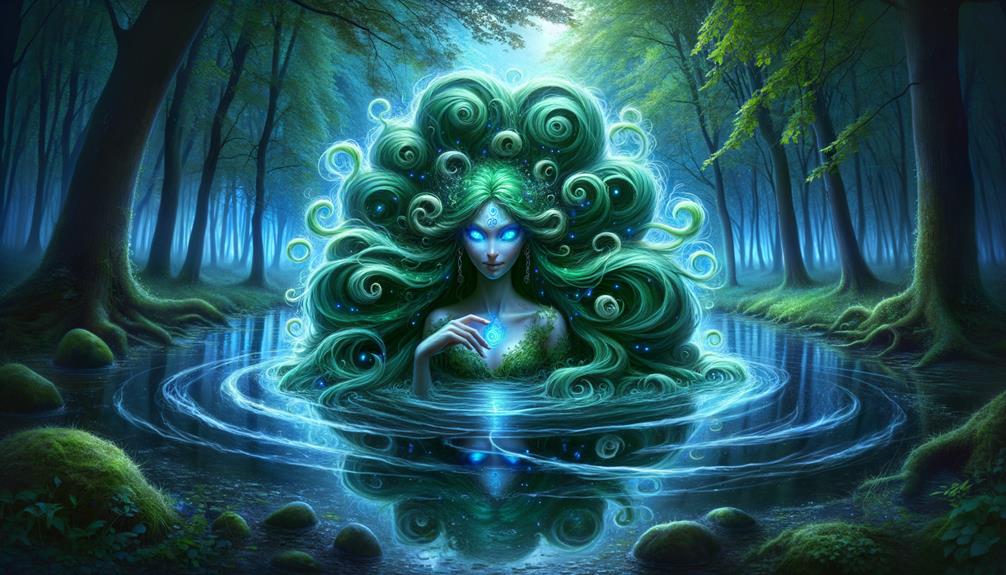Diving into the Depths of the Rusalka: A Slavic Water Spirit
Isn't it incredible how folklore perfectly captures the essence of a society's dread, aspirations, and core beliefs? For example, let's unpack the Rusalka, a mesmerizing Slavic water spirit, that has held generations spellbound. Through my research into this ethereal being, I've come to appreciate its complex nature and contradictory facets, symbolizing both the enchantment and danger inherent in the natural world.
Typically portrayed as a stunning woman, the Rusalka's alluring exterior masks her potentially lethal motives. This personification of nature's beauty and threat underscores a deep-seated reverence and caution towards the natural environment within Slavic cultures.
But there's much more to this water wraith than what's immediately apparent. What makes the Rusalka strike such a deep chord in Slavic societies? And what can her persistent existence disclose about the communities that gave birth to her legend? Let's delve deeper into the intriguing enigma of this mythical character.
The Rusalka: A Symbol of Nature's Seductive Danger
Despite her captivating appearance, the Rusalka embodies the 'beautiful but dangerous' paradigm. She's akin to a siren, whose mesmerizing song lures sailors to their doom. This serves as a reminder of nature's duality – its capacity to enthrall and destroy, reflecting the Slavic peoples' profound respect for and wariness of the natural world.
Why Does the Rusalka Resonate with Slavic Cultures?
What does the Rusalka reveal about Slavic societies? Her enduring influence suggests a deep connection between nature and these cultures, symbolizing both their admiration for its beauty and their understanding of its potential threats.
Unraveling the Rusalka: A Journey Through Slavic Folklore
Join me as we explore further and unravel the mysteries of the Rusalka, a figure deeply woven into the fabric of Slavic folklore. Our journey will take us through a rich tapestry of tales and traditions, revealing insights into the beliefs and values of the societies that created her. Together, let's uncover the layers of this fascinating character, as we dive deeper into the intriguing depths of Slavic mythology.
*“The Rusalka is a mirror, reflecting our own contradictions, our simultaneous fear and admiration of the natural world.”*
The Legend and Lore of Rusalka

Unraveling the Enigmatic Rusalka: A Slavic Water Spirit
Let's uncover the fascinating lore of the Rusalka, also referred to as the Navka, Mavka, or Lalka, a compelling symbol of tragedy, beauty, and strength deeply intertwined within Slavic culture and folklore. This mystical entity, whose name 'Rusalka' traces back to Russian and other Slavic languages, represents a spirit closely tied to fertility and crop cultivation.
Rusalkas: The Dual-Natured Water Spirits
Picture this: Rusalkas, ethereal water spirits residing in glittering crystal palaces beneath rivers, fields, and forests. Often depicted as young women who met a tragic demise, they wield the power to control water and influence the weather. Furthermore, these spirits possess a remarkable ability to shape-shift. Despite their captivating beauty, they evoke both reverence and fear. On one hand, they're cherished for their role in bolstering rye growth. On the other, their interactions with humans induce trepidation, underscoring their dual nature of benevolence and malevolence.
The Rusalka: A Deeply Rooted Slavic Symbol
In the tapestry of Slavic cultures, the Rusalka occupies a prominent position. It is not merely a figment of mythology but a potent symbol embedded in rituals, festivities, and moral stories. Even after approximately 70 generations, the alluring and tragic enigma of the Rusalka continues to ignite the imagination of literature, music, and film creators.
Our journey into the world of the Rusalka offers a glimpse into a captivating element of Slavic folklore. Its story is a testament to the enduring power and allure of cultural heritage, reminding us that even in today's fast-paced, digital world, these ancient tales continue to resonate and inspire. So, let's keep delving deeper into such intriguing myths and legends, because who knows what other fascinating tales await us?
Rusalka's Physical Description and Powers
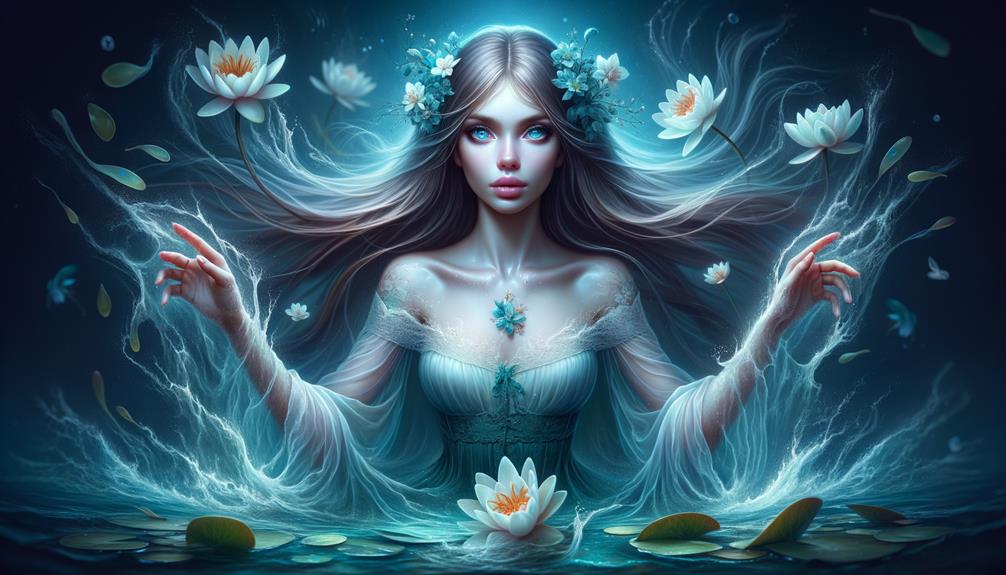
Understanding the Rusalka: A Deep Dive into Slavic Mythology
If we take a closer look at the Rusalka, an ethereal figure from Slavic mythology, we'll uncover a captivating blend of beauty, power, and mystery. Often depicted as youthful females with flowing hair, Rusalkas hold more than just a striking physical presence. They're also known for their uncanny ability to shape-shift and their choice of residence in grandiose crystal palaces hidden within lush forests or submerged in rivers.
The Rusalka: Not Just a Pretty Face
Delving deeper into Slavic lore, Rusalkas aren't just attractive young women – they're water nymphs intricately linked with water in all its forms. From controlling water to influencing weather and even promoting crop growth, their bond with nature is strong and influential.
These enchanting beings also interact with humans, especially young men. Using their beauty and captivating voices, they seduce men into the water, often leading to their downfall. This darker side of their nature has led to some Slavic traditions viewing them as unclean spirits.
The Rusalka's Power: A Spiritual Force
Rusalkas wield power that transcends the physical realm. They were respected for their ability to heal and grant wishes, reflecting their significant role in the spiritual and ritualistic life of Slavic society. Their influence weaves through the cultural tapestry, leaving a profound imprint on the collective psyche.
In Slavic languages, 'rusalka' carries a rich history and tradition, including rituals of banishment or burial. This complexity further deepens our fascination with this captivating figure.
Rusalka: A Figure of Enchantment and Intrigue
The Rusalka is more than just a figure of beauty – she's a powerful entity deeply rooted in Slavic mythology. With her enchanting voice, ability to shape-shift, and intricate connection with the natural world, the Rusalka continues to captivate and intrigue us, revealing the rich tapestry of Slavic lore.
Final Thoughts: The Rusalka's Enduring Allure
Understanding the Rusalka isn't just about appreciating her physical beauty or her intriguing powers. It's about delving into a rich cultural tradition, understanding the intricate ties between the natural and spiritual worlds, and exploring the deep history of Slavic mythology. The Rusalka is a symbol of the cultural heritage that continues to thrive in the collective imagination.
Celebrating Rusalka Week
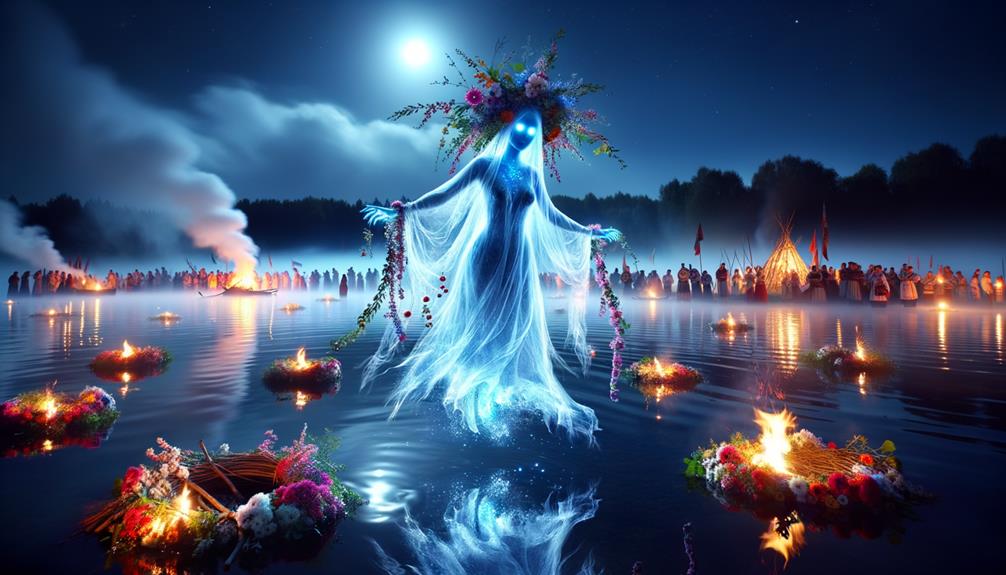
Immerse Yourself in the Enchanting Slavic Tradition: Rusalka Week
Step into the alluring realm of Slavic folklore, and you'll find yourself captivated by Rusalka Week. This enchanting celebration takes place in early June, marking the mythical emergence of water nymphs, or rusalkas, from their aquatic dwellings. As a cornerstone of Slavic paganism, this tradition is deeply ingrained in Polish culture and resonates with folk beliefs throughout the Slavic world.
The Mystical Rusalka: From Benign to Malevolent
During Rusalka Week, the normally benign rusalka transforms into a malevolent spirit, as documented by the Encyclopedia of Ukraine. These mischievous entities are known to engage in playful dances near water bodies and willow trees. The myth tells that they lure unsuspecting humans into their dance, which tragically results in drowning.
The Ritualistic Culmination: Banishing Water Spirits
The climax of Rusalka Week is a community-wide ritual aimed at banishing these water spirits. This act symbolizes the collective intention to protect the community from harm. But it's not all doom and gloom. Celebrating Rusalka Week also reflects a deep-seated respect for nature's life-giving power, especially the crucial role of water in agrarian societies.
Rusalka Week: A Celebration of Culture and Nature
This celebration is a poignant example of how cultural narratives intertwine with natural phenomena. It provides an insightful look into the human condition, as seen through the lens of myth and ritual.
Experience the Magic: Join the Celebration
Get involved in the celebration of Rusalka Week to experience the captivating blend of myth, culture, and nature. Remember, understanding and respecting traditions can enrich our own lives while preserving our shared cultural heritage.
Rusalka Week: A Tradition Rooted in Time
This celebration offers a unique perspective into the heart of Slavic folklore, providing an engaging exploration of a time-honored tradition. Mark your calendars for early June, immerse yourself in the magic of Rusalka Week, and experience a piece of Slavic history firsthand.
Rusalka in Slavic Literature and Art
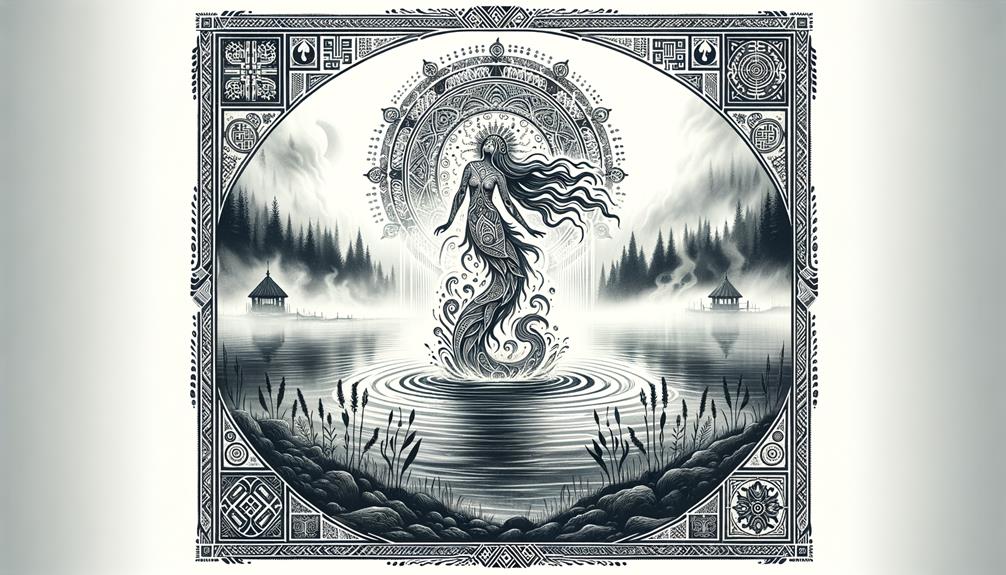
Discover the Enigmatic Rusalka in Slavic Literature and Art
Immerse yourself in the captivating world of the rusalka, a mesmerizing entity deeply ingrained in Slavic literature and art. Comparable to Hans Christian Andersen's Mermaid, these tantalizing creatures often find themselves woven into the rich tapestry of Russian fairy tales. Typically, they're depicted as stunning maidens donned in white, whose untimely demise came about through self-inflicted drowning.
The Rusalka: A Timeless Source of Creative Inspiration
The rusalka, a Slavic water spirit, has sparked the imagination, paving the way for a plethora of artistic creations. Here are some standout examples that beautifully encapsulate the allure of these creatures:
- Journey to northern Russia through its folktales, where rusalki are painted as spirits morphing into fish or snakes in daylight, only to reclaim their human form when night falls.
- Marvel at Ilya Repin's iconic painting, 'Rusalka'. This masterpiece captures a rusalka in deep thought, perched on a willow branch, thus symbolizing their intrinsic link to nature and water.
- Delve into the book 'Dancing Goddesses: Folklore, Archaeology, and the Origins of European Dance' to unearth the intriguing correlation between rusalki and fertility rituals.
The Rusalka: Unraveling the Mysteries of the Unknown
Our collective fascination with rusalki in Slavic literature and art reflects our inherent desire to decode the mysteries of the unknown. The timeless charm of the rusalka continues to entrance us, holding a firm grip on our imaginations.
Embrace the enchantment of the rusalka, and quench your thirst for knowledge through engaging literature and breathtaking art. By doing so, you will not only enrich your understanding of Slavic culture, but also add a new dimension to your appreciation of art and storytelling. Enjoy the journey as you unravel the captivating allure of the rusalka.
Modern Interpretations of Rusalka
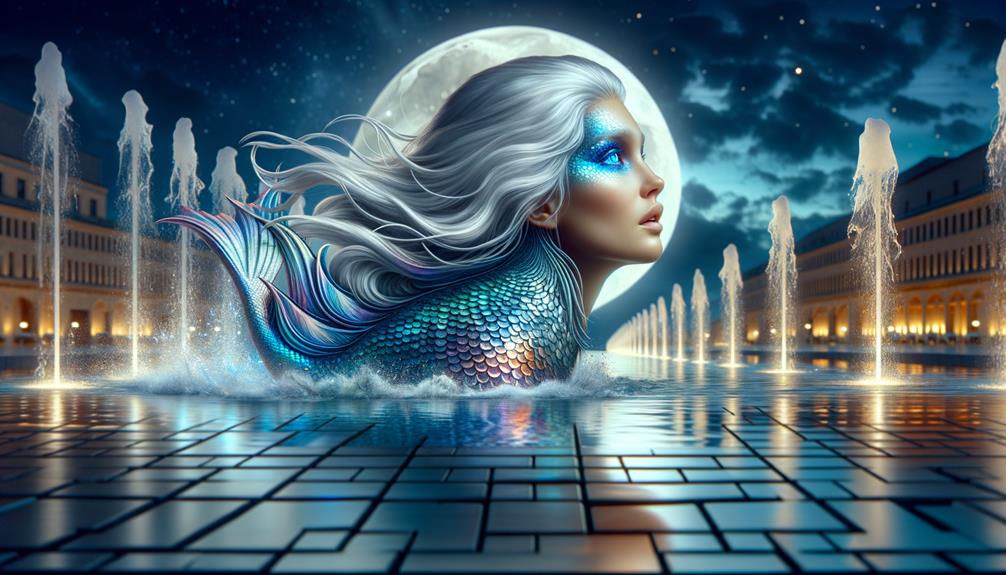
Understanding the Modern Interpretations of Rusalka
Let's delve into the contemporary implications of the Rusalka, a mystical entity that has dramatically morphed from a benevolent fertility goddess to a malevolent spirit tied to impure forces. This shift paints a captivating picture of evolving cultural perspectives. The Canadian Institute of Ukrainian Studies, under the umbrella of the University of Toronto Press, has published extensive research on this transformation.
Presently, the Rusalka, a Slavic water spirit, has taken on a sinister association with death. Particularly, it is linked to women who've ended their own lives by drowning, often triggered by the despair of carrying unwanted children or enduring a failing marriage.
Contrasting its traditional image, the modern Rusalka no longer embodies a spirit that showers life-infusing moisture on fields during spring. Instead, it has emerged as a symbol of tragedy, its seductive charm merely a façade for its perilous and malevolent intentions. This reinterpretation of the Rusalka as a harmful entity is a significant deviation from its original standing as a fertility goddess. It's a transformation that echoes the societal shifts in views on morality, femininity, and the supernatural.
Hence, it's not just about the Rusalka's reimagined profile; it's an acknowledgement of the fluidity of folklore. It constantly evolves to mirror contemporary fears, anxieties, and societal norms.
The Dynamic Nature of Folklore: A Case Study of the Rusalka
The modern interpretations of the Rusalka offer us an intriguing look into how folklore adapts to current societal trends and anxieties. It's a testament to the dynamic nature of cultural narratives, demonstrating their ability to continually reinvent themselves. This analysis not only provides us a rich understanding of the Rusalka but also emphasizes the importance of preserving and studying folklore.
Remember, the key to comprehending these evolving narratives lies in learning from reliable sources such as scholarly publications from reputable institutions like the University of Toronto Press. This allows us to engage with authentic information, enhancing our appreciation of the fascinating world of folklore.
Frequently Asked Questions
What Is the Water Spirit in Slavic Mythology?
Slavic Mythology's Water Spirit, The Enchanting Rusalka
Delving into the intriguing realm of Slavic mythology, we encounter a fascinating creature known as the 'rusalka'. The rusalka is not just any spirit. This alluring entity, often depicted as a stunning beauty, is the embodiment of water itself.
The Rusalka: Water Controller and Weather Influencer
The rusalka is believed to possess the power to govern the water. From the tiniest stream to the mightiest river, every water body is under her command. She doesn't stop there though. The rusalka also has the ability to impact the weather. Imagine a creature with the power to summon a rainstorm or clear the skies at will!
Shape-shifting Rusalka: A Friend or Foe?
Interestingly, the rusalka exhibits the fascinating trait of shape-shifting. This means she can transform her appearance, adding another layer of mystery to her character. What's more, her interactions with humans are a blend of both benevolence and malevolence. She can be as soothing as a gentle stream or as terrifying as a raging torrent, depending on her mood.
To illustrate, let's consider a real-world example. Think of the rusalka as a river during different seasons. In the spring, she is a life-giver, nurturing the land and its creatures. However, during a storm, the same river can become a destructive force, causing floods and wreaking havoc.
In essence, the water spirit in Slavic mythology, the captivating rusalka, is a complex and multifaceted character. She represents the dual nature of water – its power to create and destroy, to nourish and devastate.
To delve deeper into Slavic mythology and learn more about the rusalka, we recommend reading "The Mythology of All Races: Slavic" by Louis H. Gray. This comprehensive book provides a detailed exploration of Slavic myths, including the rusalka, with a captivating narrative that's sure to engage readers of all ages.
Who Is the Goddess of Water in Slavic Mythology?
Unveiling the Slavic Goddess of Water: A Dive into Ancient Mythology
In the rich tapestry of Slavic mythology, multiple names echo the power and influence of the Water Goddess. Known as Navia, Navka, Mavka, Lalka, or Boginka, she plays an intricate role, not just as the ruler of water bodies, but also as the controller of weather patterns.
Navia: The Water Goddess and Her Multifaceted Role
In an intriguing blend of power and poetry, Navia, the Slavic Water Goddess, emerges as a symbol of fertility. Water, the life-sustaining force, under her reign, becomes a metaphor for birth, growth, and renewal. This element of fertility linked to Navia resonates with the idea of creation and the cyclical nature of life.
Boginka and Her Weather Control: A Unique Perspective
Boginka's role extends beyond the realms of water, reaching the skies. As the controller of weather patterns, she influences the changing seasons, the rain's rhythm, and the snow's dance. Picture her as the choreographer of nature's ballet, dictating each movement with precision and grace.
The Goddess of Water: More Than Just a Myth
These myths offer a deep understanding of the Slavic people's reverence for natural elements. They demonstrate how the Goddess of Water's influence permeates every aspect of their life, from agriculture, which relies on her for rain, to their cultural practices that celebrate her.
Experience the Magic of Slavic Mythology
To dive deeper into the mystical world of Slavic mythology, I recommend reading "The Bathhouse at Midnight: An Historical Survey of Magic and Divination in Russia." This book provides a comprehensive look at various Slavic deities, including the Water Goddess, and their role within the culture.
What Is the Rusalka in Slavic Mythology?
#Understanding the Rusalka: An Intriguing Water Spirit in Slavic Mythology
Dive into the heart of Slavic mythology and encounter the Rusalka, an enthralling water spirit. Have you ever imagined a being that could both care for crops and seduce humans into the water depths? That's the Rusalka for you! She's a paradoxical figure, embodying the unbridled power and capriciousness of water.
##The Dual-natured Rusalka: Nurturer and Enchantress
The Rusalka represents a remarkable symbiosis of nurturing and enticement. On one hand, she's a benefactor to the crops, showering them with vital hydration. On the other hand, she's a siren, using her allure to draw human beings into her aquatic domain.
##The Rusalka as a Metaphor for Water's Power
In her essence, the Rusalka mirrors the unpredictable force and omnipotence of water. Have you ever stood by a serene lake, only to witness it transform into a torrent during a storm? That's the Rusalka's duality, a testament to water's multifaceted nature. *Think of the Rusalka as the spirit of water, fluid, powerful, and unpredictable.*
##The Rusalka's Role in Slavic Mythology
In Slavic myths, the Rusalka is more than just a water nymph. She is a symbol of life's contradictions and nature's whims. Her story underscores the beauty, danger, and mystery inherent to the natural world.
##Conclusion
The Rusalka is a complex and captivating figure in Slavic mythology. Her narrative engages us, reminding us of the power and unpredictability of nature. It's an adventure into the heart of Slavic folklore that is worth exploring. To delve deeper into Slavic mythology, consider reading "The Slavic Way" series by Dmitriy Kushnir, a comprehensive guide to this fascinating world of tales.
In the end, the Rusalka is a reminder that the world around us is full of mystery and charm, waiting to be discovered. So, let's dive in, shall we?
What Is the Mythical Spirit of Water?
Unraveling the Spirit of Water: A Slavic Mythology Perspective
Dive into the intriguing world of Slavic mythology, where the mystical water spirit reigns supreme. This entity, often portrayed as enchantingly beautiful yet potentially perilous, is known to hold sway over weather phenomena. Moreover, it boasts a fascinating ability to engage with human beings in myriad ways, adding a layer of mystique to its existence.
The Water Spirit: A Powerhouse of Weather Control
In Slavic folklore, the water spirit is not just a character but a force that shapes the environment. Holding the reins of weather patterns, this entity can influence the rain and the wind. The water spirit's control over the elements is a testament to its power, making it a captivating figure in cultural narratives.
A Mystical Interaction: The Water Spirit and Humans
The water spirit's interaction with humans is another facet that enhances its appeal. Whether it's a conversation with a humble fisherman or an encounter with a curious traveler, the water spirit's interactions are always steeped in intrigue. These interactions underscore the spirit's ability to bridge the gap between the human and supernatural realms.
Final Thoughts: The Enigmatic Water Spirit
The water spirit in Slavic mythology is more than just a story. It's a symbol of the natural world's beauty, power, and mystery. Its ability to control weather and interact with humans makes it a compelling figure within mythology. Whether you're a fan of folklore or curious about different cultures, exploring the water spirit's narrative offers a unique perspective on how societies understand and relate to their environment.

